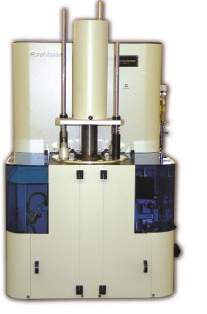
Description
Mercury Intrusion Porosimeter (MIP) is a powerful technique utilized for the characterization of pore size distribution, pore volume and porosity of a variety of solid and powder materials. Samples analyzed by this technique are placed in a sample cell with liquid mercury surrounding the sample. Force is applied to intrude the mercury into any voids or pores within the sample bed. Larger voids and pores will fill first, at lower pressure. As the pressure behind the mercury increases, smaller and smaller pores will begin to fill. The volume of mercury intruded into the sample is recorded at each pressure point. The Washburn Equation is then used to relate the applied pressure to a pore diameter. The volume of mercury intruded into the sample at each pore diameter can then be reported.
Instruments utilized at PTL allow for pressures ranging from approximately 1 psi up to 35,000 psi which correlates to measurement of pores from about 250 µm to 0.003 µm (3 nm). MIP is recognized by several standards and guidance agencies, including the ISO, ASTM, USP and EP. This technology is widely used across multiple industries including petrochemical, automotive, catalysis, biomedical and pharmaceutical companies.
By using MIP to evaluate pore size, pore volume, and porosity of substrates, PTL has identified differences between manufacturers, pinpointed problems in processing conditions, and provided routine quality control testing to numerous industries
Capabilities
Low Pressure:
- Stations: 2
- Pressure range: 1.5 - 350 kPa (0.2 - 50 psi)
- Pore size range:* 950 - 4.26μm
- *Using contact angle of 140 degrees per IUPAC recommendations
High Pressure:
- Stations: 1 (PoreMaster)
- 2 (PoreMaster GT)
- Pressure range: 140 kPa - 231 MPa (20 - 33000 psi, PoreMaster 33)
- Pore size range: 10.66 - 0.0064μm (PoreMaster 33)
Example data
Location: RFM 1236
Manager: Dr. Casey Smith, casey.smith@txstate.edu
Model: PM 20 PoroWin™ Version: 8.1
